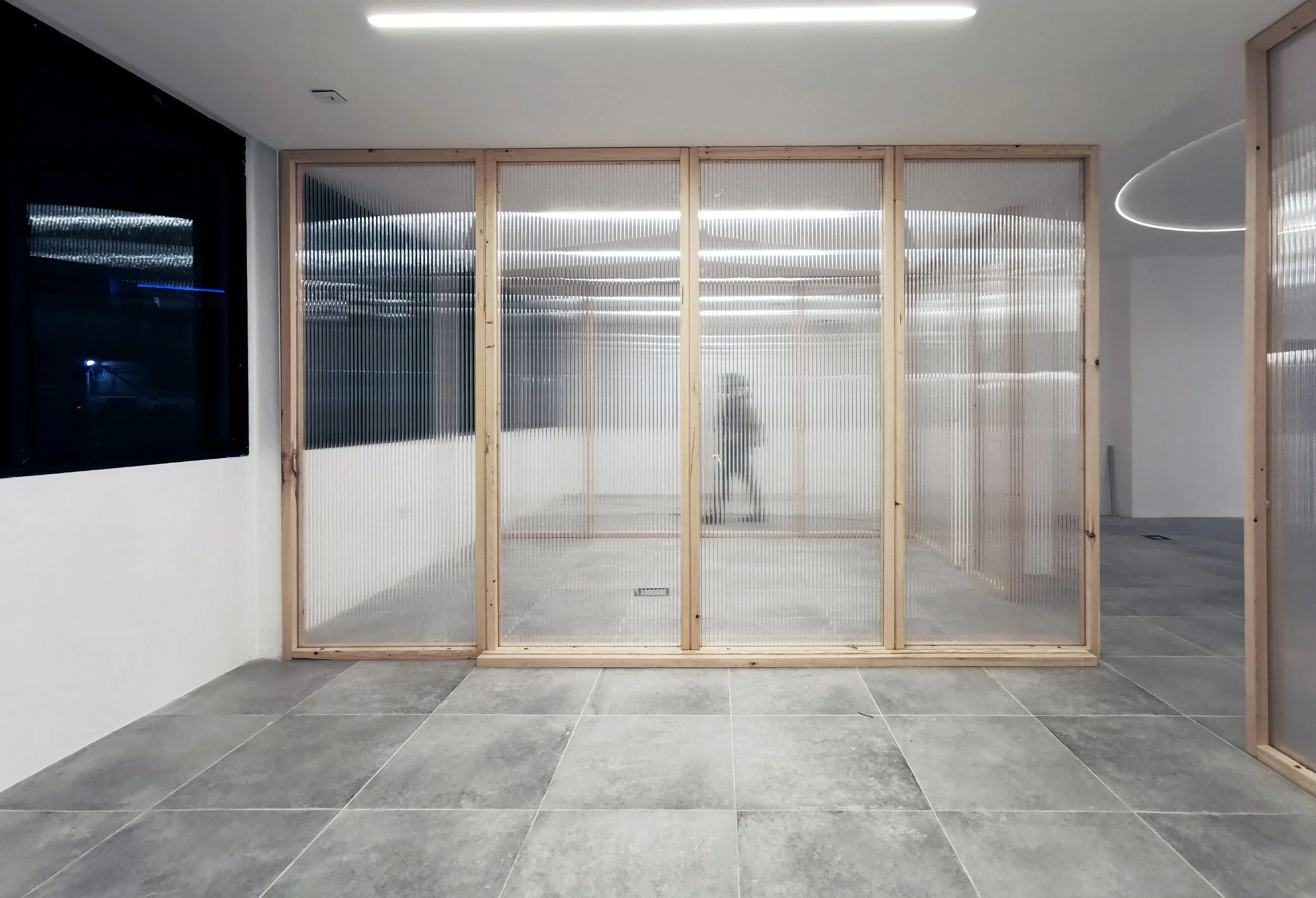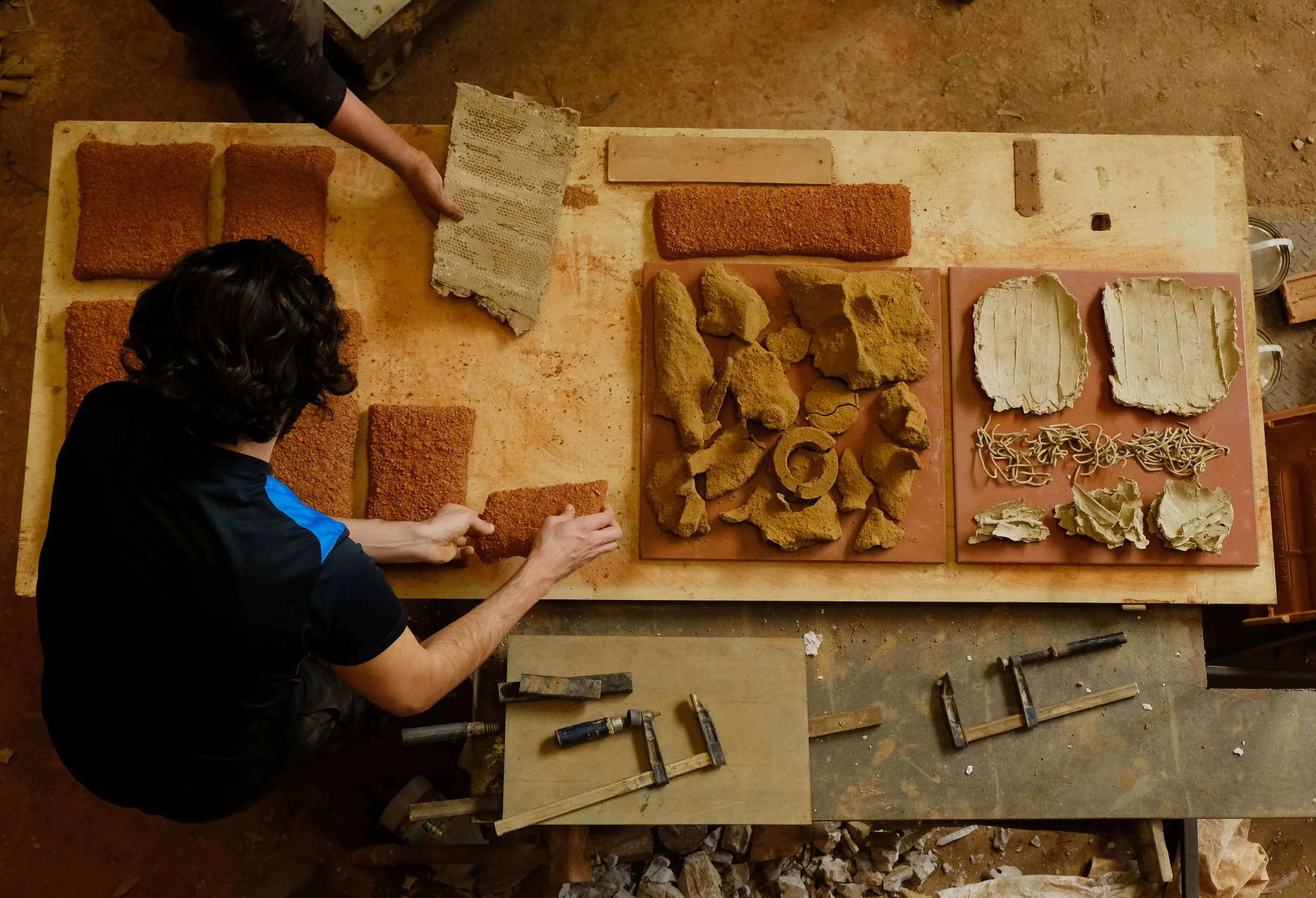Reimagining Reparations & Repair
Reimagining
Reparations & Repair
Article for ARQUINE September 2024 written by Adrian Muller with Arine Aprahamian
Polyglot Technical College interior at night. Photo by MULLERAPRAHAMIAN
MULLER APRAHAMIAN is an architecture and spatial design practice founded in Lebanon in 2018 by Adrian Muller and Arine Aprahamian.
Polyglot is our first interior renovation project, at home in Beirut.
POLYGLOT Technical College, Lebanon
Since 1972, students have come to learn technical, digital, and language skills at Polyglot. The school is spread across a few floors of a mixed-use apartment building located just off the bustling Dora roundabout, connecting main transport arteries into and out of Lebanon’s capital, Beirut, and to the North. This area is one of the busiest and most ethnically diverse transport and migrant hubs in the country.
The ages and backgrounds of students attending Polyglot reflect the vibrant diversity of Dora, along with the wide variety of valuable, transferable skills taught here. From languages to typing, translation, software, electronics maintenance and repair, and nails & beauty, the curriculum is ever-evolving, with course offerings kept relevant and accessible at different entry levels.
From one-on-one instruction to group teaching and larger classroom settings, the new interiors encourage transparent and shared learning. The space is divided with natural unpainted timber frames, supporting translucent polycarbonate walls. Polycarbonate is a versatile, dependable, strong material used for thermal and sound insulation while allowing light through. It is stronger, far lighter, and easier to implement than glass, and comes in clear transparent, frosted translucent, or colored varieties with different degrees of structural ribbing depending on need. The clear panels used here help keep classroom sounds and the noise of the neighboring highway at bay, while maintaining visibility and a light, dynamic, welcoming atmosphere.
Being a low-income neighbourhood and establishment, the school provided us with a modest budget for the renovation, which was an exciting challenge to work within. To reduce costs and allow for more versatility in the design-build process we served as contractors for the project and received the funds for the renovation upfront to procure materials and hire skilled artisans and laborers. However, a few days into the project, the October revolution in Beirut erupted when the banks began to fail and triggered the real-time collapse of the Lebanese lira and the onset of an historic hyperinflation that would last five years.
For decades, the lira had been pegged to the dollar and allegedly backed by gold held in US reserves. Suddenly, the currency began to free-fall, losing more than half its worth over the coming months of construction, and ultimately settling to less than 2% of its original value, today. Our modest budget and our novice contracting and project management skills were tested in a trial by inflation and a race against the market. With a sudden drop in purchasing power, we faced the reality of a fluid market where prices of imported construction materials fluctuated (mainly rising uncontrollably) daily and even hourly. Square-footage of tiles, or meters of tubing, cable trays, wire, and fixtures, all changing prices, turning an already dynamic and limited-means design-build project into an impossibly challenging first dance with an uprooted economy in limbo.
The rollercoaster experience brought our attention to the material networks and supply chains that underpin our world. It also highlighted the fickle nature of capital and market, revealing new forms of material and skill based economies, placing human beings at the centre of our conversation. Locality takes on new meaning, the existing has new value, and expertise, craft, vernacular and embodied knowledge become invaluable.
Photo by Adrian Muller Terraforma: Tile specimens.
Home is where the Earth Is
At this critical departure point in our practice, we were confronted with the unsettling revelation of the fragile and extensive networks, volatile market mechanics and extractive capitalist realities shaping the built environment, both at home and abroad. Beirut enjoys an intimate relationship to craft, with workshops and artisan studios scattered all throughout the city, as well as industrial zones that are close to the centre and largely informal allowing for easy access to industry and manufacturing. With capital flight, inflation, and loss of purchasing power, the rest of the world became literally out of reach, grounding us to look towards local industry, the land around us, and materials beneath our feet: the earth.
This sparked Terraforma, our ongoing collaboration with a brick factory to experiment with clay–our oldest building material–and ceramics, the first human technology. The austere climate in the country meant the construction sector had ground to a halt. Ironically, this freed up manufacturers and industries, allowing them to indulge our ideas and proposals. We applied for and were awarded a grant from the EU to produce research and experiments with Lebanon’s sole brick and heavy-clay manufacturer and maker of the iconic traditional red Lebanese terracotta roof tiles, to innovate the canonical building material of clay and introduce new reverence for the earth and local industry.
With the grant, we produced experiments and tile samples, ushering in a new chapter of clay and brick production in the country. The construction lull induced by the collapse of the banks and the worsening economic climate proved fertile ground for breeding new ideas and collaborations, and also introduced a new mindset and approach to building. More crucially, living in unchartered times and overcoming relentless, shape-shifting obstacles has provided us with a newfound perspective that now informs our architectural practice.
Photo by Vicken Avakian Terraforma: Experiments and prototyping at the clay factory.
This fresh perspective informs our approach and affects how we design, build, value, assess, celebrate, contribute to, and participate in the built environment. Architects are tasked with seeing and relating beyond their site and physical environs, often slipping between different horizons in space and time, leaning on the past and into the future to elicit and encounter histories, unearthing hidden value and missed opportunities in the objects, spaces and systems that surround us. Our visions, gestures and touch, for better or worse, define and shape the look, feel, quality, and effects of reality for many, in one-off encounters or through prolonged exposure over years and even generations.
How does conscious and duty-bound architecture reflect this trans-local, inter-generational awareness, bringing political, fiscal, and social reparations to communities, users, and societies, while also providing material, sustainable, and symbiotic reparations to the discipline and art of architecture and the medium of the built and natural environments themselves?
A radical response would be to stop building altogether. However, where building anew is necessary, the more inside-out, not outside-in the better… that is: site, community, and local environment coming together to conjure, synthesize and co-create the future through building. Our experience with Polyglot, the lira, and Terraforma has catalyzed a new approach for our studio practice, prioritizing the existing, the earth and its offerings, and enabling enriching collaborations and encounters for the end user and the neighboring community throughout the process.
Holiday Inn, Beirut. Photo by Djedj on Pixabay.
Politics of (Dis)repair
In August of 2020, less than one year from the completion of our renovation project, and in the grip of a pandemic and a crippling economic collapse, the Beirut port–a mere 5km away from Dora–explodes in one of the most violent eruptions in history; devastating the city. Today, 4 years on from the horror, there is no tangible repair or reparations for all the damage and neglect that enabled such a tragedy and injustice. Apart from the community and NGO-initiated repairs of homes and the city, much of the port itself still lays mostly in ruin, the haunting grain silos towering at the epicentre of the blast. Beirut is no stranger to violent destruction, and this port-and-citywide devastation is only the most recent in a series of unfortunate chapters in its long and traumatic history. In the wake of destructive episodes like the blast, the Civil war, or Israel’s total onslaught on Lebanon’s infrastructure in 2006 (with roads, bridges, the airport, power plants, and water treatment facilities bombed), Beirut is seemingly a city in a constant state of repair.
From 1975–1990 the country was plunged into a bloody civil war, the scars of which are visible all throughout the capital. Three decades later, while there is still no formal or official narrative, museum, or monument dedicated to the 15-year war in Lebanon, Beirut is a city of informal, de facto monuments to disrepair—markers of violent, destructive histories, unchecked policies, and significant moments from the war and beyond. Whether it is the shelling-scarred and derelict Holiday Inn, once a hotel-turned-barracks, or the unfinished concrete skeleton of Burj el-Murr, towering with squat floors that disregard building codes, the illegal over-development of the coastline, or the gargantuan decaying, smoldering port grain-silos ruin, like an heirloom tapestry singed and frayed, stitched and sutured, the urban fabric here bears witness to decades of perpetual (dis)repair.
Architecture is a political and often capitalist tool in its design, construction, repair, and indeed disrepair. Many of the remaining, mostly-vacant heritage-architecture buildings of Beirut are left by their landlords to deteriorate as they wait for their last-one-standing old-contract tenants to pass away, releasing their apartments and allowing the buildings to vacate and fall prey to aggressive, unchecked development in the city. The redevelopment of Down Town Beirut after the Civil war, primarily through forced expulsion and appropriation of land by the private sector, namely Solidere, polished up the city to resemble European capitals, attracting foreign visitors and investment, yet rendering the heart of the city a soulless veneer of pristine put-togetherness.
Perhaps this contrast of Down Town Beirut with the otherwise ambient state of suspended repair and the whispers of looming dereliction woven into the fabric of the city old-and-new, is jarring; a persistent reminder that capital, the markets and corruption are at play, and the past with its scars may be doctored, if not entirely sanitized from view. In the case of the grain silos and Holiday Inn however, these ruins serve as monuments to unreconciled pasts; landmarks, towering in the city's streets…reminders of reparations and justice that may never come.
The Beirut Port Silos after the 2020 explosion. Photo by Rashid Khreiss on Unsplash (Colored)






